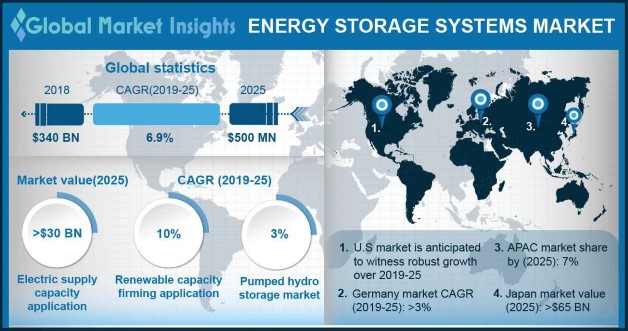3 major trends influencing energy storage systems market dynamics
Publisher : Fractovia | Published Date : 2019-08-29Request Sample
Rising demand for uninterrupted power supply coupled with shifting trends towards utilization of renewable energy will influence energy storage systems market trends over 2019-2025. Energy storage systems are indispensable to the operation of power systems, as they ensure continuity of energy supply and improve reliability of the system. The scalability, size and cost of an energy storage system vastly depends on the form of the stored energy. Energy can be stored as kinetic, potential, chemical, thermal and electromagnetic, etc.
UK Energy storage systems Market Size, By Technology, 2018 & 2025 (USD Million)

With the widespread adoption of renewable energy resources, energy storage is becoming equally useful. As renewable energy sources are intermittent in nature, storing the energy produced and using it when required is witnessing large scale demand. Energy storage technology provides reliable stream of power throughout the day.
Warehousing energy from diverse resources for use at different times is one of the major applications of energy storage. Storage technologies improve the quality of power through frequency regulation, allowing companies to produce cheap and efficient power systems, to provide an uninterruptible source of power for critical infrastructure and services.
Solar power is becoming increasingly popular, and more homeowners are exploring how they can store more of the energy generated by solar panels with battery storage. For instance, the United States was the second biggest energy storage market in 2018 and the residential sector played a significant role in adding impetus to energy storage systems market share.
Some of the major trends that will influence the energy storage systems market outlook are as follows:
Government initiatives to add growth scope to energy storage systems market size
The energy storage systems market is witnessing substantial growth owing to declining energy storage costs as well as rising consumer awareness for the need of clean energy technologies. Governments across the globe are introducing policies to promote the utilization of renewable energy, which is positively influencing energy storage systems market. For instance, The California Public Utilities Commission implemented a storage procurement mandate of 1,325 MW of storage by 2020 for three investor-owned utilities of the state. Massachusetts, Hawaii, New York, Maryland, Nevada and New Jersey have also adopted storage regulations and mandates.
Governments in various nations have widely adopted the practice of offering financial incentives to support scaled up deployment of renewable energy and energy storage systems. As of 2015, nearly 48 countries have undertaken financial incentivization to support renewable energy and energy storage systems deployment. Friendly policies by governments across the globe is expected to stimulate energy storage systems market across Asia and Europe as well.
Concern for the environment to encourage energy storage initiatives
With growing concerns about the environmental impacts of fossil fuels, policymakers and engineers are increasingly turning their attention to energy storage solutions. The demand for a more dynamic and cleaner grid has led to a significant increase in the development of new energy storage projects.
As per IEA (International Energy Association), in order to keep global warming below 2 degrees Celsius, the world needs approximately 266 gigawatt of energy storage by 2030. Under current trends, it has been estimated that the global energy storage market will hit that target and grow quickly to a cumulative 942 gigawatt by 2040, representing USD 620 billion in investment over the next two decades.
Large-scale energy storage is gradually registering a growing prevalence. For instance, in 2017, the U.S. generated 4 billion MWh of electricity, but only had 431 MWh of electricity storage was available. PSH (Pumped-storage hydropower) is by far the most popular form of energy storage in the U.S. where it accounts for 95% of utility-scale energy storage. As per the U.S. DOE (Department of Energy), pumped storage hydropower has increased by 2 GW in the last decade. By the end of 2017, there was approximately 708 megawatt of large-scale battery storage operational in the United States energy grid.
Declining costs of energy storage solution to boost energy storage systems market expansion
In the past decade, cost of solar energy, wind energy and energy storage have all dramatically declined, resulting in more competitive solutions that pair storage with renewable energy and hence propelling energy storage systems market. For instance, in a bid for a project by Xcel Energy in Colorado, the median price for wind and energy storage was USD 21/MWh and was USD 36/MWh for solar & storage. When compared to $18.10/MWh and $29.50/MWh, respectively, for wind and solar solutions without storage, it is evident that energy storage, though an extremely useful technology adds minimally to cost of renewable energy resources.
Much of the price decrease is due to the falling costs of lithium-ion batteries. From 2010-2016, battery costs for electric vehicles (which is similar to the technology used for storage) fell 73%. Recent research indicate that the cost of energy storage systems will also continue to decrease, opening greater growth opportunities to augment energy storage systems market share.
energy storage systems market trends are anticipated to significantly impacted by growing environmental concerns, government policies to promote renewable energy and declining cost of energy storage, over the forecast timeline. As per Global Market Insights estimates, energy storage systems market size is expected to surpass USD 500 billion by 2025.